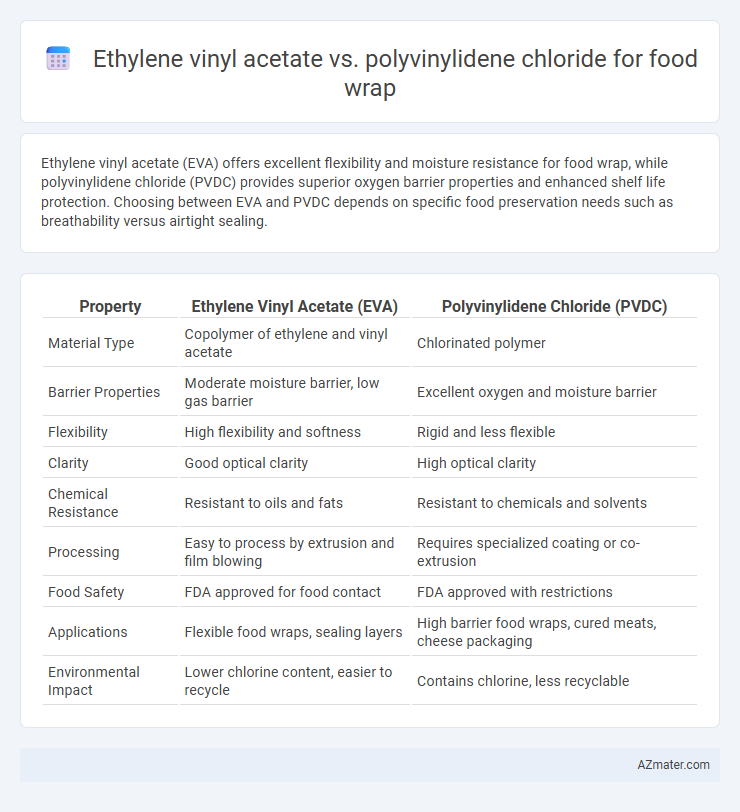Ethylene vinyl acetate (EVA) offers excellent flexibility and moisture resistance for food wrap, while polyvinylidene chloride (PVDC) provides superior oxygen barrier properties and enhanced shelf life protection. Choosing between EVA and PVDC depends on specific food preservation needs such as breathability versus airtight sealing.
Table of Comparison
| Property | Ethylene Vinyl Acetate (EVA) | Polyvinylidene Chloride (PVDC) |
|---|---|---|
| Material Type | Copolymer of ethylene and vinyl acetate | Chlorinated polymer |
| Barrier Properties | Moderate moisture barrier, low gas barrier | Excellent oxygen and moisture barrier |
| Flexibility | High flexibility and softness | Rigid and less flexible |
| Clarity | Good optical clarity | High optical clarity |
| Chemical Resistance | Resistant to oils and fats | Resistant to chemicals and solvents |
| Processing | Easy to process by extrusion and film blowing | Requires specialized coating or co-extrusion |
| Food Safety | FDA approved for food contact | FDA approved with restrictions |
| Applications | Flexible food wraps, sealing layers | High barrier food wraps, cured meats, cheese packaging |
| Environmental Impact | Lower chlorine content, easier to recycle | Contains chlorine, less recyclable |
Introduction to Food Wrap Materials
Ethylene vinyl acetate (EVA) offers excellent flexibility and clarity, making it a popular choice for food wrap applications that require durable and stretchable packaging. Polyvinylidene chloride (PVDC) provides superior barrier properties against oxygen, moisture, and odors, ensuring longer shelf life for perishable food items. Both materials serve critical roles in preserving food quality, with EVA excelling in mechanical performance and PVDC specializing in protective packaging.
Overview of Ethylene Vinyl Acetate (EVA)
Ethylene Vinyl Acetate (EVA) is a flexible, transparent polymer widely used in food wrap applications due to its excellent clarity, toughness, and grease resistance. EVA films provide superior elasticity and sealability compared to Polyvinylidene Chloride (PVDC), making them highly effective for preserving freshness and preventing contamination. The material's resistance to low temperatures and its non-toxic properties ensure safe food packaging while maintaining product quality.
Overview of Polyvinylidene Chloride (PVDC)
Polyvinylidene chloride (PVDC) is a high-barrier polymer commonly used in food wrap due to its excellent oxygen, moisture, and aroma barrier properties, which significantly extend the shelf life of perishable products. It displays superior chemical resistance and maintains clarity, making it ideal for packaging applications requiring both product protection and visual appeal. While more expensive and less flexible than Ethylene vinyl acetate (EVA), PVDC's barrier performance is critical in maintaining food freshness in challenging storage conditions.
Barrier Properties: Oxygen and Moisture
Ethylene vinyl acetate (EVA) offers moderate moisture barrier properties but lower oxygen barrier performance compared to polyvinylidene chloride (PVDC), which provides superior oxygen and moisture resistance essential for extending food shelf life. PVDC films exhibit excellent impermeability to gases and water vapor, making them ideal for packaging products sensitive to oxidation and moisture. While EVA enhances flexibility and sealability, PVDC's barrier properties are more effective in preserving food freshness and quality.
Clarity and Transparency Comparison
Ethylene vinyl acetate (EVA) offers excellent clarity and transparency, making it a popular choice for food wrap applications where high visual appeal is essential. Polyvinylidene chloride (PVDC) also provides good transparency but tends to have a slightly hazier appearance compared to EVA, which can impact the visual presentation of wrapped food. EVA's superior clarity enhances product visibility, while PVDC prioritizes barrier properties over optical performance.
Food Safety and Regulatory Compliance
Ethylene vinyl acetate (EVA) offers excellent flexibility and clarity but may have lower barrier properties against oxygen and moisture compared to polyvinylidene chloride (PVDC), which provides superior food preservation by effectively preventing gas and moisture transmission. PVDC films comply with stringent FDA and EFSA regulations for food contact, ensuring minimal migration of harmful substances, while EVA requires careful formulation to meet similar food safety standards. Choosing PVDC over EVA enhances regulatory compliance and extends shelf life, critical factors in food packaging for maintaining product safety and quality.
Flexibility and Seal Performance
Ethylene vinyl acetate (EVA) offers superior flexibility and excellent heat-sealing properties, making it ideal for tightly wrapping irregularly shaped food items while maintaining a reliable seal. Polyvinylidene chloride (PVDC) excels in providing an exceptional gas barrier and durability but is less flexible compared to EVA, which may limit its conformity to varied food contours. EVA's combination of elasticity and strong seal performance enhances its functionality in food wrap applications, whereas PVDC's strength lies in extending shelf life through barrier protection.
Environmental Impact and Recyclability
Ethylene vinyl acetate (EVA) is a flexible, non-toxic polymer often used in food wraps with moderate environmental impact due to its partial biodegradability and limited recyclability, primarily through mechanical recycling processes. Polyvinylidene chloride (PVDC), known for its superior barrier properties, poses higher environmental concerns due to its chlorine content, which complicates recycling and leads to potential release of toxic byproducts during incineration or degradation. EVA food wraps are generally more eco-friendly and easier to recycle, whereas PVDC's environmental footprint is larger, necessitating specialized disposal methods to mitigate landfill accumulation and pollution.
Cost Considerations for Manufacturers
Ethylene vinyl acetate (EVA) offers a lower production cost compared to polyvinylidene chloride (PVDC), making it a budget-friendly choice for food wrap manufacturers. EVA films provide flexibility and clarity with less expensive raw materials, reducing overall manufacturing expenses. In contrast, PVDC incurs higher costs due to complex processing and expensive chlorine-based components, impacting the final product price.
Choosing the Right Film: EVA vs PVDC
Ethylene vinyl acetate (EVA) offers superior flexibility and clarity, making it ideal for food wraps requiring stretchability and easy handling. Polyvinylidene chloride (PVDC) provides excellent barrier properties against oxygen, moisture, and odors, extending shelf life for perishable foods. Selecting between EVA and PVDC depends on desired film characteristics, where EVA suits applications needing elasticity, while PVDC excels in moisture and gas barrier performance.

Infographic: Ethylene vinyl acetate vs Polyvinylidene chloride for Food wrap
 azmater.com
azmater.com